Turkish food is having a moment locally, thank goodness. And from some masterful chefs. Chef duo Laura and Sayat Ozyilmaz opened Dalida in San Francisco on June 30, 2023, in one of the Presidio’s striking brick buildings lining the Main Parade Lawn, within eyesight of the Bay and Golden Gate Bridge, surrounded by forests.

Dalida combines influences from the Middle East and Greece. But Turkey is the soul of the offerings, expressing Sayat’s home city of Istanbul, while Laura imparts influence from her Guerrero and Mexico City roots.
The couple met at the U.S.’ most prestigious cooking school, the CIA (Culinary Institute of America in Hyde Park, NY). They were beloved for their pop-up Istanbul Modern and as opening chefs of Noosh (since all the Noosh controversy when the entire staff was terminated overnight, I never returned to Noosh, knowing the recipes I loved there were the Ozyilmazes).
I was curious to see how Dalida would express the cuisine via their varied and impressive cooking histories: Laura at legends like Mugaritz in Spain, Eleven Madison Park and Café Boulud in NYC and Saison in SF; Sayat at NY’s iconic Blue Hill at Stone Barns and Le Bernardin, and SF’s own Mourad. At Dalida, I’m delighted to say I’m tasting modern Turkish food that could deserve a Michelin star or other such accolades.
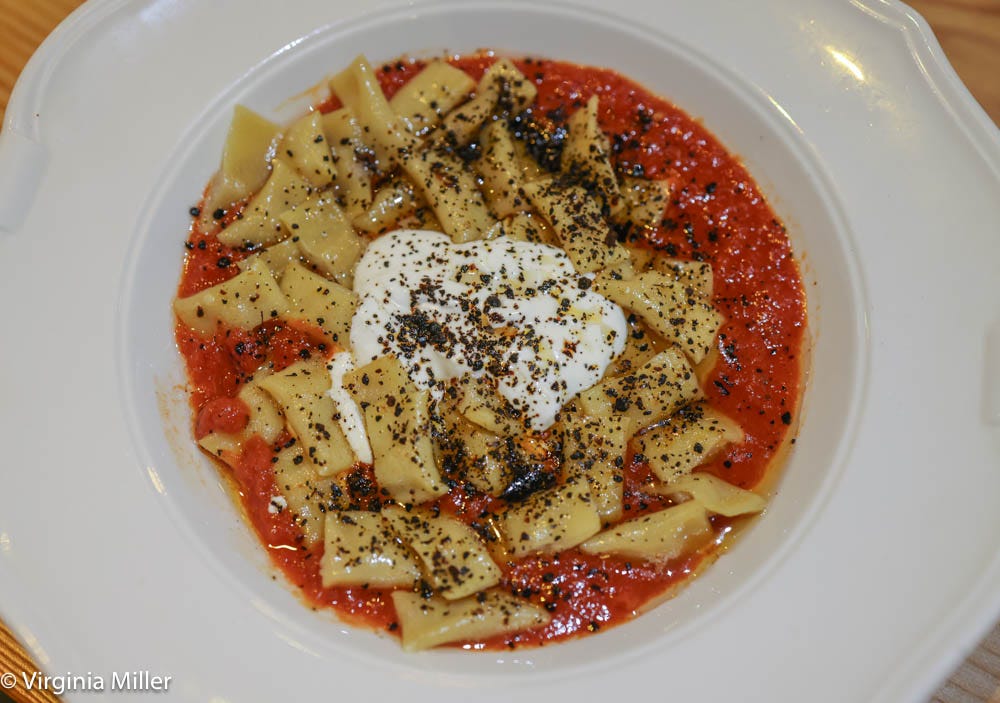
Entering the casual space, the first thing I notice is the hand-painted murals and wallpaper created by Oakland-based artist Emily Parkinson, a long-time friend Laura first met at Eleven Madison Park in NYC. Besides an array of my beloved birds, the walls depict flora and fauna from the surrounding Presidio, an unparalleled park in any city. In fact, Dalida sources fresh flowers and herbs from the Presidio’s community garden, used in tinctures for their drinks and beyond. But more of that in a minute.
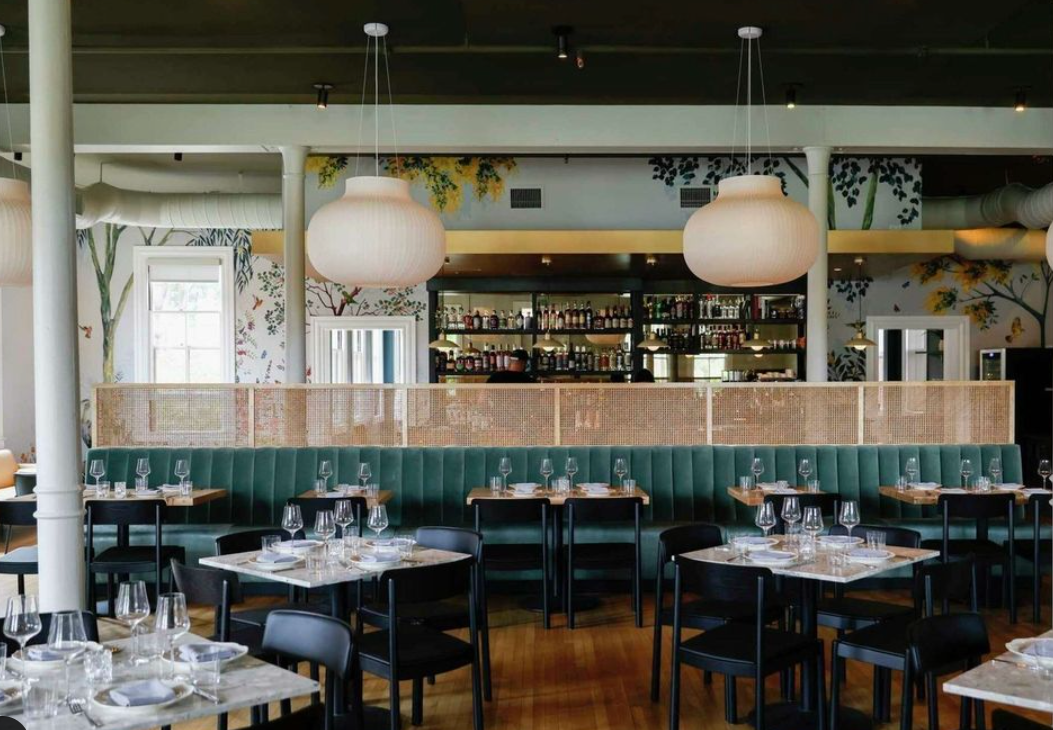
The casual, warm space was designed by Jenne Wicht of JAK W. The soothing main dining room and bar area are defined by warm woods, neutral tones, reclaimed Douglas fir wood tables, Scandinavian lighting and custom Moroccan mirrors, while the chef’s counter dining room is brighter.
Dalida is named after Sayat’s mother. In Polish-Yiddish, this translates to dahlia, San Francisco’s official city flower. I was moved to know the name honors both the familial and their adopted home city. The act of “breaking bread” (an ancient, Biblical expression), of communing together and sharing a meal across the table, is the inspiring spirit behind Dalida. That’s easy to do with bread this good and a broad range of shared plates, from smaller meze to Middle Eastern pastas or whole meats and fish. Lamb, seafood and other crucial cultural ingredients are all here, but a garden, vegetable-driven focus means it’s easy for vegetarians to make it a plant-based meal. So much is made in-house, whether Turkish-style ice creams or house nocino (walnut liqueur).

As my partner Dan (“The Renaissance Man”) and I settled into drink menus, we beelined straight to the anise spirits selection. I wrote of the raki offerings at aforementioned Meyhouse, but immediately noticed Dalida’s more extensive list of Turkish raki (the country’s ubiquitous grape-raisin-based clear brandy flavored with anise) and similar anise spirits of neighboring countries: Greek ouzo and Lebanese arak plus French pastis and anisette. Dalida ambitiously hopes to have the largest anise spirit selection in the city — alongside a rich offering of other brandies like eaux de vie. I strongly support this vision and have long written about all too short-lived places that tried to blaze this brandy trail, like arak-heavy Amoura, eaux de vie/schnaps haven Trocadero Club, or pioneering brandy bar, Trou Normand.
The brandy spirits collection would already make this a bar destination. Then there are bar manager Evan Williams’ cocktails. He’s bartended and run programs at greats I wrote about since opening: Bar Agricole, Beehive, Hard Water. Eastern Mediterranean ingredients (yogurt, spices, preserved fruits) and herbs foraged from the surrounding Presidio (eucalyptus, rose geranium, yerba buena) center his cocktail menu, inspired by the sites and smells of a Middle Eastern bazaar.
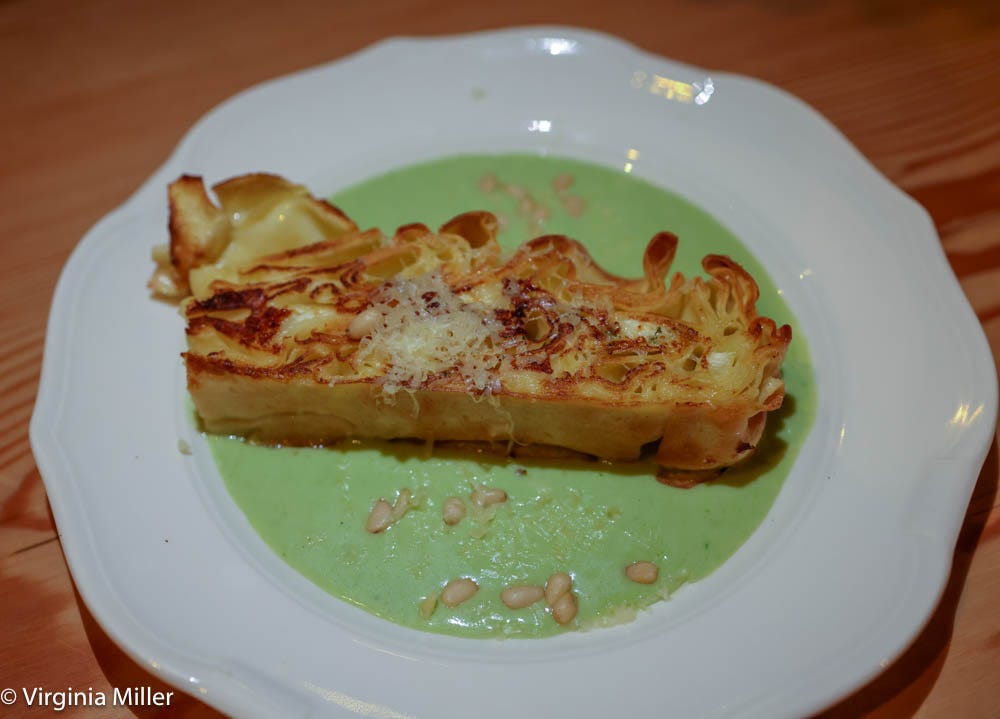
While I can’t resist the olive-laden Anatolian Martini, drinks like Pic-anic Basket (choice of spirit but you should go gin to amp up those green flavors!) showcase celery, green apple, tarragon, lemon and bubbles in a more layered yet crushable way than a lot of celery green apple cocktails do. Saturnalia is a good-time Tiki twist with yogurt and a Lebanese 7-spice blend bringing the Middle East to a house rum blend, caramelized pineapple and lime.
Many clarified milk punches I taste globally these days veer too sweet, remembering when they were more balanced 15 years ago in SF. Williams’ Pasha cocktail is balanced: savory, naturally sweet and fresh with tequila, house tomato grenadine, strawberry and thyme mountain tea, clarified in milk. Non-alcoholic drinks are also thoughtful, whether sesame tahini horchata or tamarindo: tamarind, smoky urfa biber chili pepper, lime, bubbles.
Wine director Ruth Frey (Aster, Mourad) is another shining light in this strong team, including a couple of rock star servers/waitstaff we recognized (they remembered us, too) from former restaurants. The wine list holds the most well known Middle Eastern producer, Chateau Musar, offering 20 years of their wines. You’ll find Armenian (tributing Sayat’s Armenian roots), Lebanese and Eastern European small producers alongside Western Europe and Californian wineries who employ mindful farming. We relished Frey’s wine pairings, from a savory 2019 Amiran Vepkhvadze Tsitska amber/orange wine from Krakhuna, Georgia, to a peppery, berry, anise-layered 2020 Zorah Karasi red wine from Armenia, made from one of the oldest grape varieties in history: Areni Noir.
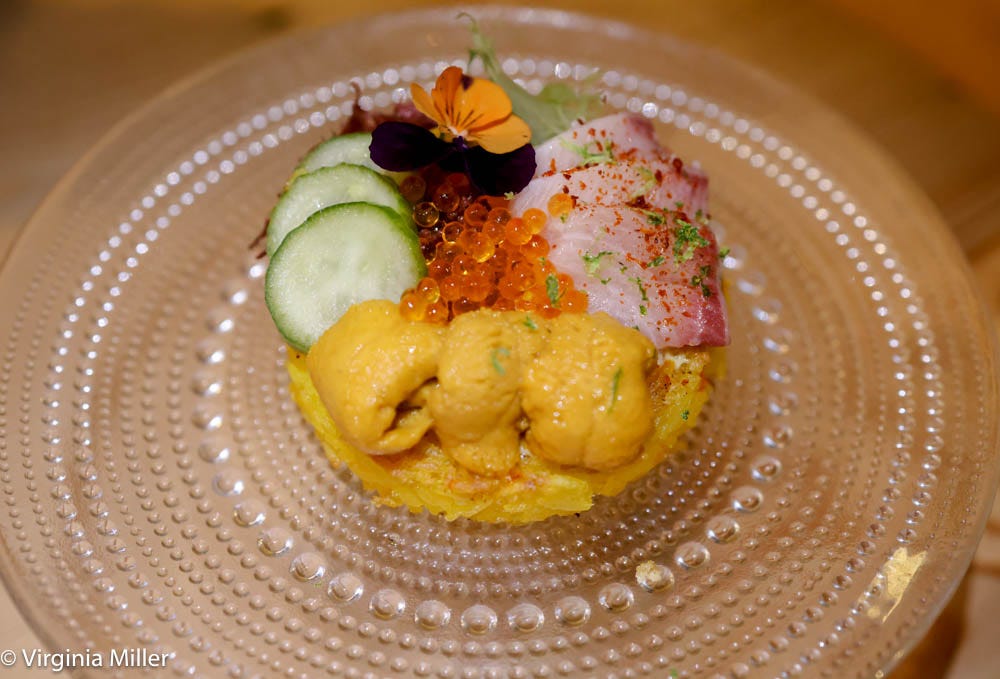
Now let’s dig into the food from the array Dan and I sampled (there’s a very reasonable per person $75 chef’s tasting menu if you want to try a cross-section). I missed the Ozyilmaz’ fluffy Middle Eastern pita bread and dips from Noosh days. It’s all evolved yet nurturingly delicious as I remember: that fluffy, warm pita, rich hummus, muhammara and smoked yogurt with pickles and marinated olives. With Syrian roots but common in Turkish and Western Armenian cuisine, muhammara is my all-time favorite Middle Eastern dip — yes, even over hummus. It’s a lively, often rosy-red blend of ground walnuts, red bell peppers, pomegranate molasses and breadcrumbs. Dalida’s version is one of the best in SF — and I’ve tasted dozens of great versions here.
A few unusual starters in the “ocean, land and garden” small plates menu sections surprise. A decadent sea urchin tahdig is a round of crispy rice, a play on traditional Iranian tahdig: crispy basmati rice, typically infused with saffron and turmeric. The dish goes oh-so-California artfully topped with Santa Barbara uni/sea urchin, smoked trout roe, raw kampachi (greater amberjack), edible flowers and preserved yuzu. It’s silky, crispy, umami and clean.
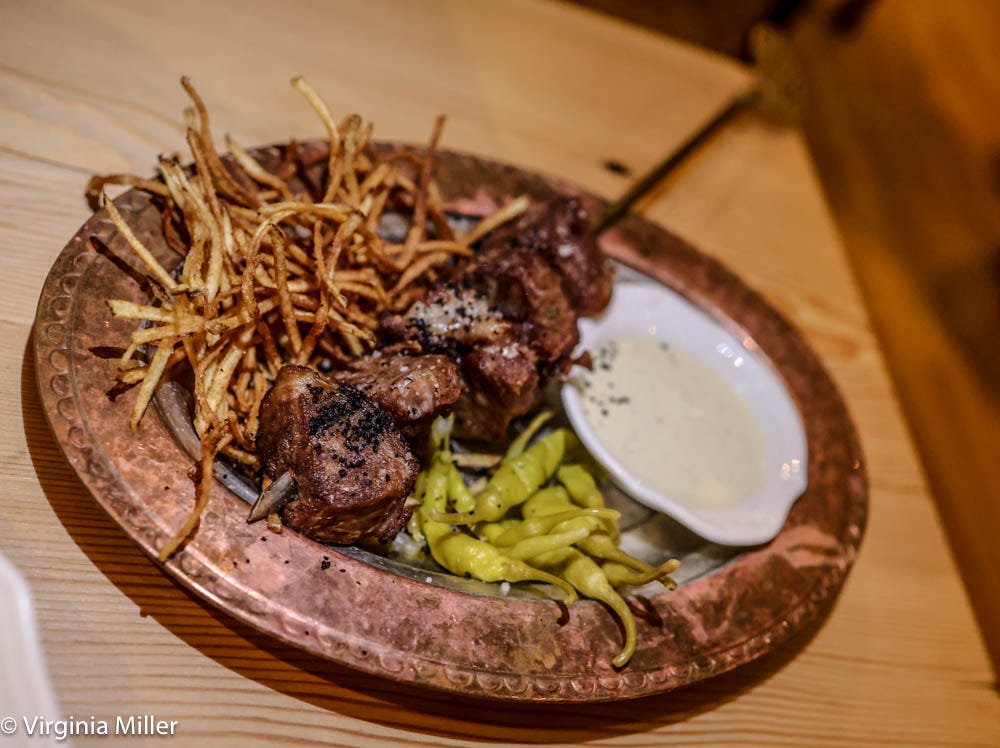
Midye dolma is a playful dish common in Istanbul street food. Mussels stuffed with cold rice, currants and pinenuts tastes of the sea with sweet, nutty contrast. As chef Sayat explained to us, you take one half of the mussel shell as a sort of spoon to scoop out the “stuffed” elements. Zeytinyagli enginar is an Aegean/Turkish dish of artichoke bottoms. Here, it’s confit artichokes and fennel dotted with fluffy feta in orange-dill dressing. It’s so NorCal and Middle East simultaneously. Another small plate worth mentioning is meaty-mustardy Iberico pork jowl souvlaki (Greek skewer-grilled) partnered with paper-thin strips of fried potatoes in a creamy mustard sauce.
Middle Eastern pastas corner a small-but-notable menu section. Su borek may be the most interesting: a lasagna-esque strip of pan-roasted yufka pastry. Layered with comte cheese, it’s baked, then pan-roasted in butter, teeming in a soft green spinach-comte cheese sauce, dotted with pine nuts. But Kayseri manti, or butter-roasted lamb dumplings doused in garlic yogurt and tomato sauce, is what I am already craving and dreaming of going back for. Manti is already one of my top Turkish dishes, but this style of smaller, mini-dumplings hails from Kayseri, a city and province in Turkey. When I asked our server what was making this tomato sauce so blessedly tart and vibrant, they said pomegranate was added to already glorious in-season tomatoes. It’s one dreamy Turkish pasta.

You could keep the feast at small plates but larger plates abound (serving two to four), as do grilled meats and all-important-to-Middle-Eastern-food lamb. We tried tender baby lamb ribs in smoked lebni yogurt and zippy zhug herb sauce, plus Cypriot lamb chops with hummus, lamb jus and chives. The dense, filling vegetarian entreé most reminded me of Laura’s partial roots in Mexico City, tasting like it could have come from MX’s Rosetta: a hefty steamed corn masa wrapped in grape leaves is enlivened by stewed beluga lentils in apricot charoset fruits and nuts sauce, with Mexico-meets-Middle East vibes.

My greatest dessert temptation was their housemade Turkish ice creams. I can’t help it: the Italian half and non-sweet tooth in me leans towards gelato and sorbetto as the ideal dessert post-feast, whereas pastry and richer desserts are what I want with espresso for breakfast when my stomach is empty and appetite fresh. But I’m so glad we tried pastry chef Sude Terek’s layered “baklava.” Paper-thin phyllo pastries are piled up in an artful Napoleon-like stack, layered with pistachio cremeux and Antep pistachios from Turkey, dusted in ground pistachios with raspberry sauce poured tableside. It’s a dark pink-and-green melange that dissolves in the mouth.
But Dalida’s ice cream is as lovely as it sounded, especially our chosen duo of tart sour cherry with cooling, herbaceous melon anise. Turkish-style ice cream usually includes sahlep, a starchy flour made from the tubers of an orchid flower, imparting a somewhat elastic, stretchy texture.
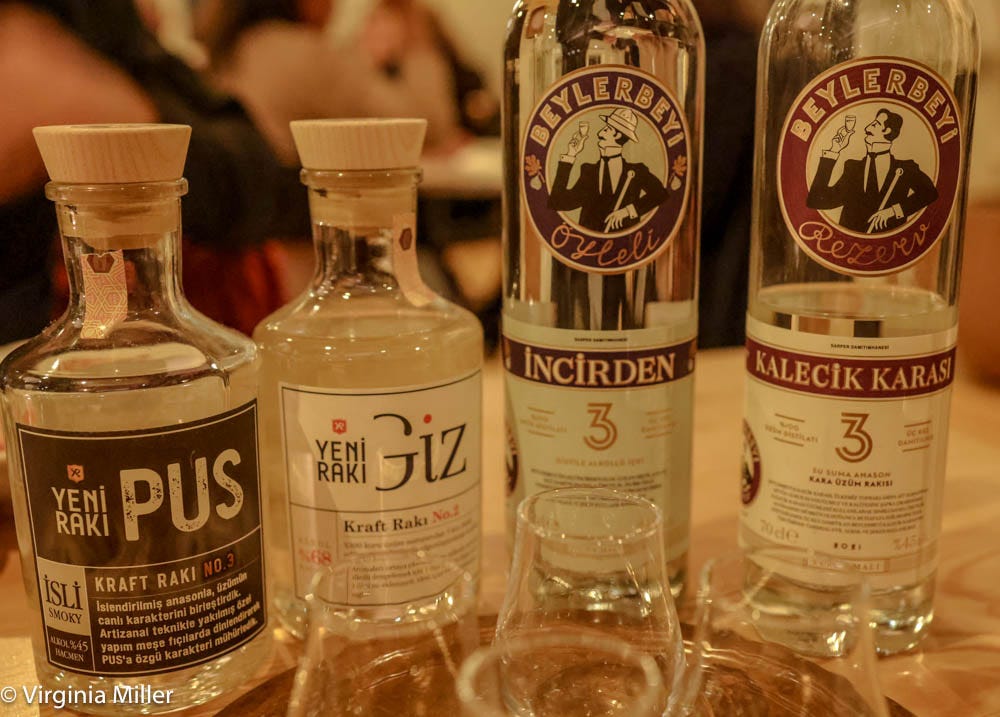
Tasting through a flight of raki post-dinner with ice and water for proper cloudy luging is one of my favorite Turkish experiences. We tasted from producers I’m well familiar with, Yeni and Beylerbeyi, but tried rarities in their line. I wasn’t surprised to find my favorite was the old school Kulüp Raki, which Dalida’s raki expert described as “old gentleman’s raki.” It was the most traditional, the most anise-y. And I dug the classic label. While others unfolded with nuanced layers of herbs, Kulup was bold, silky, a licorice bomb. Yes.
The U.S.’ Turkish population is small outside the biggest populations in NY and NJ, reflected in less Turkish restaurants and sometimes minimal understanding of its unique dishes. A few SF Turkish gems have been going strong for years like Kitchen Istanbul, or more recent arrivals such as Taksim last year and Bistro Ember this summer. Dalida is next level modern Turkish (and surrounding countries), where the food and drink are equally strong. With warm service and space, it epitomizes “whole package.”
Those herbal raki whispers lingered on my tongue as we walked out among the eucalyptus, pine and California cypress trees that pack Presidio’s 2.4 square miles. Aromatic and alive, I was at home, relishing yet another only-in-SF moment eating as we did inside a wild park in the city. But this moment echoed of Mexico (not just our neighbor, but California’s rootsy core), Turkish hospitality and the heartwarming flavors of Turkey and surrounding countries expressed with SF vision.
// 101 Montgomery Street, Suite 100 (include zip code 94129 in directions to avoid misdirection to same downtown address), www.dalidasf.com
Virginia Miller is a San Francisco-based food & drink writer.
The Bold Italic is a non-profit media organization, and we publish first-person perspectives about San Francisco and the Bay Area. Donate to us today.







